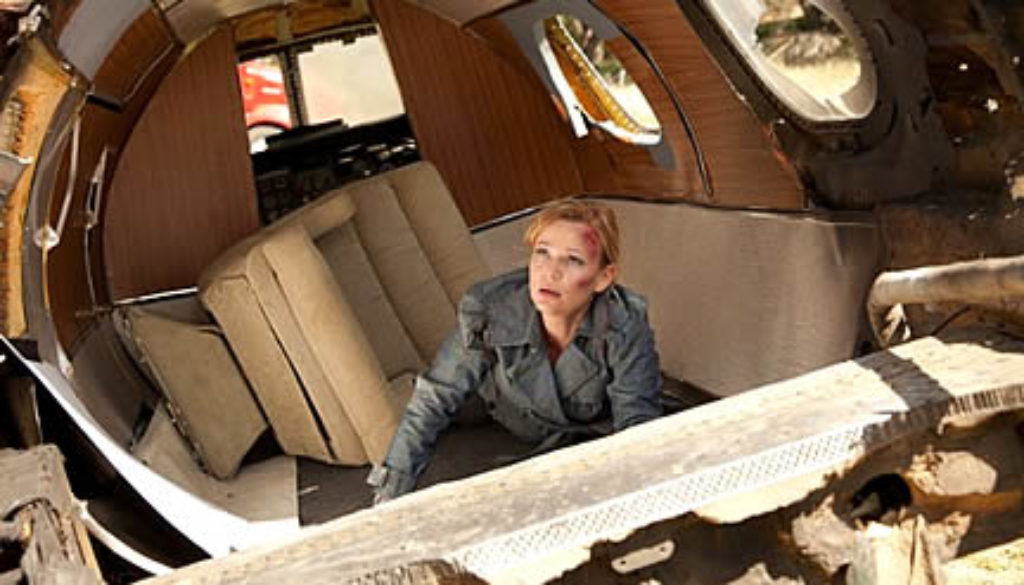
Who is John Galt?
That question continues to haunt plucky protagonist Dagny Taggart as the curtain opens on Atlas Shrugged II: The Strike. Dagny, as we learned in the first installment (Atlas Shrugged) of this cinematic adaptation of Ayn Rand’s 1957 novel, is among a handful of determined capitalists struggling to stave off complete economic and social collapse—a collapse, they believe, that’s being hastened if not engineered by a government bent on mandating “fairness” and “equality” at the expense of free enterprise and entrepreneurial ingenuity.
Joining Dagny in her struggle against the government’s increasingly zealous regulation of just about everything is her illicit lover, billionaire steel manufacturer Henry Rearden; longtime friend and copper mine owner Francisco d’Anconia; and coal mine operator Ken Danagger. Arrayed against her are a constellation of foes, including rabid government regulator Wesley Mouch; her brother, James, the ostensible head of her family’s railroad company; and Rearden’s scheming wife, Lillian.
But there’s more going on than just massive unemployment (24%), stratospheric gas prices ($42 a gallon) and nonstop protests by the poor. Even as Dagny struggles to keep Taggart Transcontinental Rail solvent, intrepid captains of industry, as well as artists, inventors and others who care about excellence, just keep … disappearing.
And it all has something to do with the mysterious man known as John Galt.
Meanwhile, Dagny has also discovered a mysterious motor—a motor, it seems, that runs off latent static electricity and holds the promise to create enough power to power, well, everything. If only she could find its creator so she could get it working again! But time is running out as the global economic crisis goes from bad to worse, prompting the government to start nationalizing companies … such as her own.
Dagny and Rearden’s continued resistance to governmental takeover is depicted as heroic as they cling tenaciously to their vision of capitalism’s virtues.
When a government scientist suggests to Dagny that she patent the motor, she replies, “I don’t want credit for something I didn’t create.” The scientist responds with something akin to awe, saying that she’s a person of “uncommon character.” Dagny’s character is perhaps also evident in her growing awareness of the poverty all around her. Repeatedly we see her furrow her brow as she looks at poor protesters and other reminders of the savage toll the economy’s fall has taken on people. It’s unclear exactly what she’s thinking, but it seems at the very least that she longs for a world in which all citizens might have a chance to find meaningful work and provision. (It’s an inference I make based on her generously rewarding the hard work of one of her current employees.)
Elsewhere, Rearden risks his life to save a man in an industrial accident. The metal magnate also refuses to be intimidated or cowed by government agents’ intimidating tactics. (The determination of whether or not he goes too far in his refusal to cooperate with new laws has everything to do with one’s politics: If one deems the government evil in its long-armed tactics, Rearden is guilty of nothing more than standing firm in his patriotic duty to protect freedom. If not, then he is surely overstepping his rights as a citizen.)
Just before a cataclysmic train accident, a dispatcher suggests that the only thing left to do is pray.
Dagny and Rearden continue the affair they began in the first film. They’re briefly shown in bed together. (She’s wearing a clingy camisole; he’s still fully dressed.) Their kiss and rolling embrace fades to black.
Rearden is later shown returning to his own room, where his wife interrogates him about his whereabouts the night before. She knows he’s having an affair, but she refuses to let him divorce her (as he’d like to do) because she’s clinging to the power and influence that being his wife affords her. She calls him a “hypocrite” and a “lying, cheating man who can’t keep his pants zipped.” He replies coolly, “You’re entitled to that.”
James is shown in bed with his wife. (She’s wearing a low-cut negligee.) Several female characters, Dagny included, wear cleavage-revealing tops.
Trains collide explosively in a tunnel. Tanker cars full of flammable material fly off the tracks into tunnel walls, sparking a conflagration that collapses the structure (we see) and kills (we hear later) all of the estimated 400 people aboard the two trains. An airplane crashes, breaking into pieces, some of which explode and burn.
Two other incidents also involve fire. An accident at Rearden’s steel mill results in molten metal spilling onto the floor, triggering a blaze that shuts down the factory. (We see one man’s arms on fire, and Rearden jumps to save another man from a falling beam.) A copper mine is destroyed by explosions, and we see fire shooting out of holes in the ground.
James is jostled roughly by protestors as he gets out of his limo and tries to walk into his New York City office. Someone observes that humans will always subjugate their fellows, and if not by way of money, then it will be with blood, whips and chains.
God’s named is abused four or five times; three times it’s paired with “d‑‑n.” “H‑‑‑” is said four times, “d‑‑n” five times and “a‑‑” three times, while “b‑‑ch” and “b‑‑tard” are spoken once each.
People drink wine and champagne in several scenes. The camera zooms in on two still-smoldering cigarettes in an ashtray.
An official blackmails Rearden into signing over his company to the government by confronting him with compromising pictures of Rearden and Dagny kissing. Rather than submit to government regulations and ownership of his company, d’Anconia masterminds the destruction of his copper mines, a ploy that not only destroys his company but further hobbles the already ailing world economy as well.
Rearden is proud of his completely self-interested motivations, bragging, “I do not recognize the good of others as justification for my existence.”
In Ayn Rand’s vision of the world, there are two kinds of people: There are those who create, who produce, who imagine a better future and who work hard to make that future happen; and there are the parasites who live off the wealth and value those entrepreneurs create. Throughout this story, industrialist Henry Rearden minces no words in describing people in the second category: “Thieves,” “burglars” and “looters,” he calls them, spitting the words from his mouth in contempt.
Unfettered capitalism can, as the film claims, free and motivate individuals to give their best efforts. And productive labor certainly benefits society as a whole as people pursue their own individual interests. In contrast, a government that grows too heavy-handed (illustrated by excessive taxes, burdensome business regulations, forced income redistribution and control of the markets) saps individuals and corporations of their motivation, contributes to cultural malaise and ultimately blunts the pursuit of excellence—even as the very imbalances and inequities that are supposed to be vanquished grow ever more obvious.
But the world Rand has imagined in Atlas Shrugged could hardly be more starkly defined and divided. There’s no nuance here; no three-dimensional characters. It’s an approach that lends itself to the film’s increasingly melodramatic—and occasionally profane and sensual—take on the schism between heroic, die-hard capitalists and a nefarious government bent on assimilating everything in its misguided slouch toward full-on communism.
Lest anyone somehow miss the impossible-to-miss pro-capitalism theme woven throughout Atlas Shrugged II, its credits close with this quote from Rand: “Money is the barometer of society’s virtue.” For Rand, a noted atheist, a culture’s accumulated wealth (and the power, influence and possessions that inevitably go with it) was the only thing that mattered. Anything that hindered such acquisition—the public good included—deserved stern scrutiny and sharp censure. Given that, the story continues to argue, the only proper stance is to fight for more and to fight to the death against anyone who might try to take it from you.
Rand’s is certainly a conversation-provoking perspective … as well as a doggedly materialistic one that leaves little room for spiritual considerations in an utterly political landscape.


After serving as an associate editor at NavPress’ Discipleship Journal and consulting editor for Current Thoughts and Trends, Adam now oversees the editing and publishing of Plugged In’s reviews as the site’s director. He and his wife, Jennifer, have three children. In their free time, the Holzes enjoy playing games, a variety of musical instruments, swimming and … watching movies.
Our weekly newsletter will keep you in the loop on the biggest things happening in entertainment and technology. Sign up today, and we’ll send you a chapter from the new Plugged In book, Becoming a Screen-Savvy Family, that focuses on how to implement a “screentime reset” in your family!